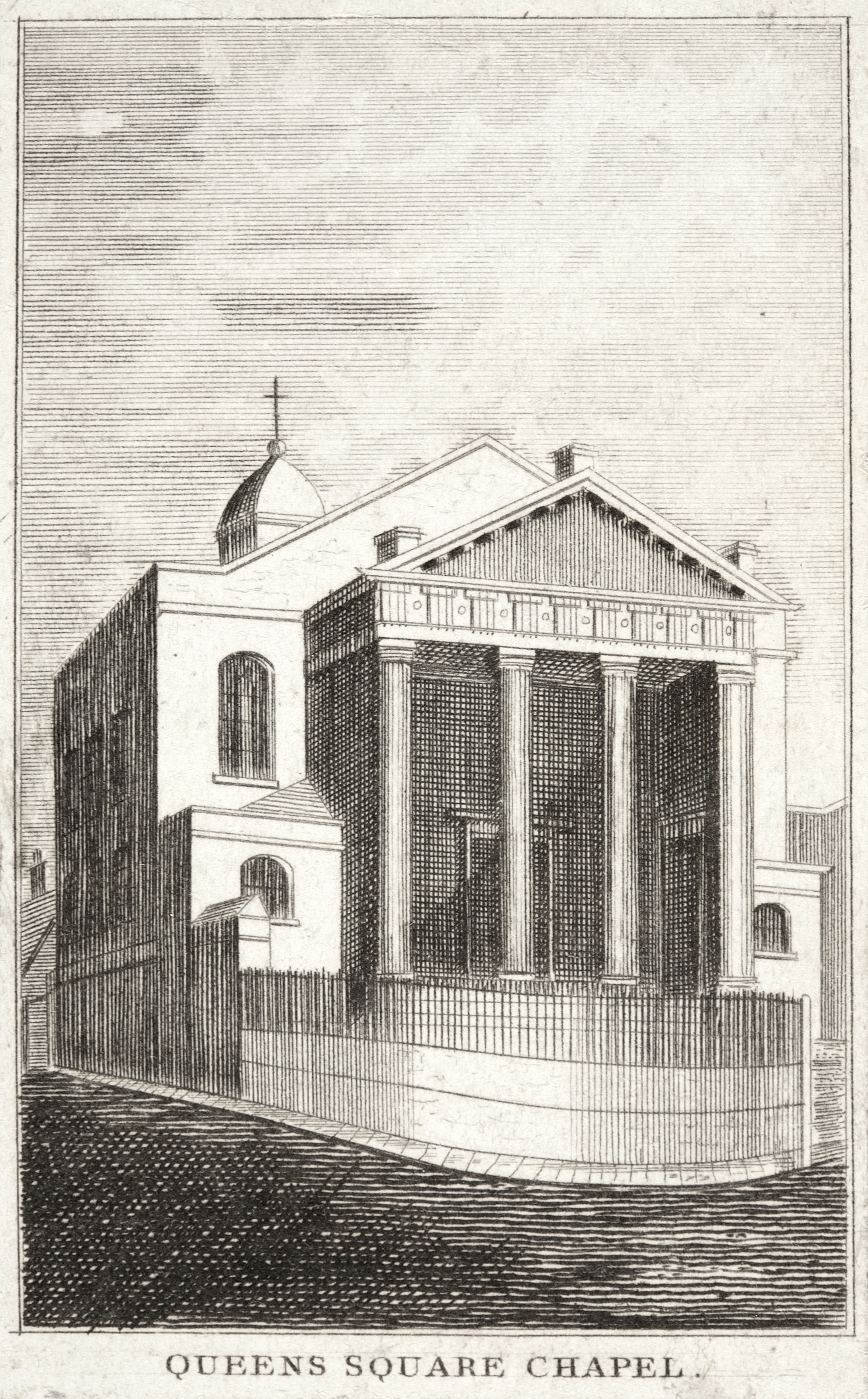
Image Courtesy of Bath in Time - Bath Central Library
In A Description of Bath by John Wood (1765) on p312 in a section on chapels “the first of those Edifices is that inscribed with the name of blessed Virgin Mary; it is situated near the South West Corner of Queen Square . . . This Chapel was founded and built by me, for the Use of the Inhabitants of the new buildings in the north west corner of the city; it was part of my original design for those building, having intended it for a termination, westward, to the street on the south side of Queen Square . . .”. The foundation stone was laid on 25 Mar 1732. This was followed by an invitation to subscribers. The building was opened on Christmas Day 1734.
There was a legal dispute instigated by the Rector of St Swithin’s over the legal basis for the chapel, resting on the question of whether or not the chapel had ever been consecrated. In addition to a letter to the Bath Chronicle there was a volume entitled The history, and evidence of consecration of St. Mary's Chapel, Queen Square, Bath: together with a correspondence relating to the Chapel, which recently took place between the Rev. the Rector of Walcot, and the proprietor and minister of the said Chapel by Henry Brougham William Hillcoat & Charles Abel Moysey (Bath: 1827)
A statement of facts, by the way of question and answer, relative to the controversy of St. Mary's Chapel, Queen Square, Bath by Henry Brougham William Hillcoat (Bath, 1831). This volume, dated as 28 Sep 1831 by H B W Hillcoat of Coombe Down, addresses the question as to whether the chapel was legally qualified as a chapel within the Church of England. The registers of the chapel “have been separate and distinct from the parish register from the year 1754”. The matters arose because a judge had ruled that “registers, where there is no authority legally given and publicly known to set them forth as separate registered, could not be received in evidence.” This threw into doubt the legality of marriages previously held there and threatened to curtail further baptisms, marriages and burials. When writing in 1831 it is stated that “at least forty-nine bodies” had been buried there. In the appendix it quotes the original book of accounts belonging to the shareholders of the chapel which has entries for 1734-5 “for copy of act of consecration, for carriage of writing to the Bishop; &c. &c. forty-nine burials at least”. The volume refers to vaults but it unclear whether these were in the grounds or in the crypt. However, as reported in the Bath Chronicle of Thu 25 Oct 1827 p3 “Friday as some workmen were clearing away rubbish from the vaults of St Mary’s Chapel, Queen-square, they discovered a small table of white marble, bearing the following inscription:—“Thomas Omer died the third day of Jan. 1734, aged 7 years. The first deposited in these vaults.”

Chapel location on Basnett map of circa 1770
The British Magazine and Monthly Register of Religious and Ecclesiastical Information etc Volume III (1833) by Hugh James Rose, Samuel Roffey Maitland has a report on two Anglican clergy leaving the church. One was William Morshead, late assistant minister at St Mary’s Chapel, Bath. He had written a pamphlet accusing the Church of England of ‘apostacy’.
St Paul’s Church, Monmouth Place (later called Holy Trinity) was completed in 1881. It had taken 8 years from the laying of the foundation stone to its opening. As reported in the Bath Chronicle of Thu 26 May 1881 “It will be remembered that the erection of the church was rendered necessary by the purchase and subsequent demolition of St. Mary’s Proprietary Chapel, Queen-square, some nine or ten years ago, by the Midland Railway Company, to enable them to convert Chapel-row into a more convenient approach to their station in Seymour-street. Simultaneously with the demolition of this chapel, the history of which dated back to the time of Wood, the erection of a new and more commodious building was commenced on an adjoining site.”
It would seem any surviving wall memorials from the chapel were transferred to St Paul’s church as the Bath Weekly Chronicle and Herald of Sat 26 Jun 1937 p21 had a report on a Service of Remembrance at St Paul’s for Col Robert Alexander Bull and this has “He was buried in the churchyard of St. Mary’s Chapel, on the site of which St. Paul’s Church was built in 1873, and in which there is a memorial tablet to the Colonel.” The church (in 1952 rededicated as Holy Trinity) closed after 2000 and was being offered for sale. It was Grade II list by Historic England in 2011 and the description includes ‘Three wall monuments older than church and may come from St Mary's Chapel, Queen Square, demolished in c.1870. Neo-classical style. One to Col. Robert Bull died 1833, veteran of the Peninsular and Waterloo, with trophy of arms. Another to daughter, also signed Biggs, and third to an Indian veteran.‘ As reported in 2021 (https://bathnewseum.com/2021/08/13/latest-on-future-of-baths-holy-trinity-church/) "Spaceworks (the owners) have recently achieved Planning Consent to convert the church to studio work/office space."
Limitations
The register has, at the beginning, a list of 49 burials in the period 1734-1827. However these have no dates, not even a year, and except for the one in 1734 for which there is a date have been omitted.